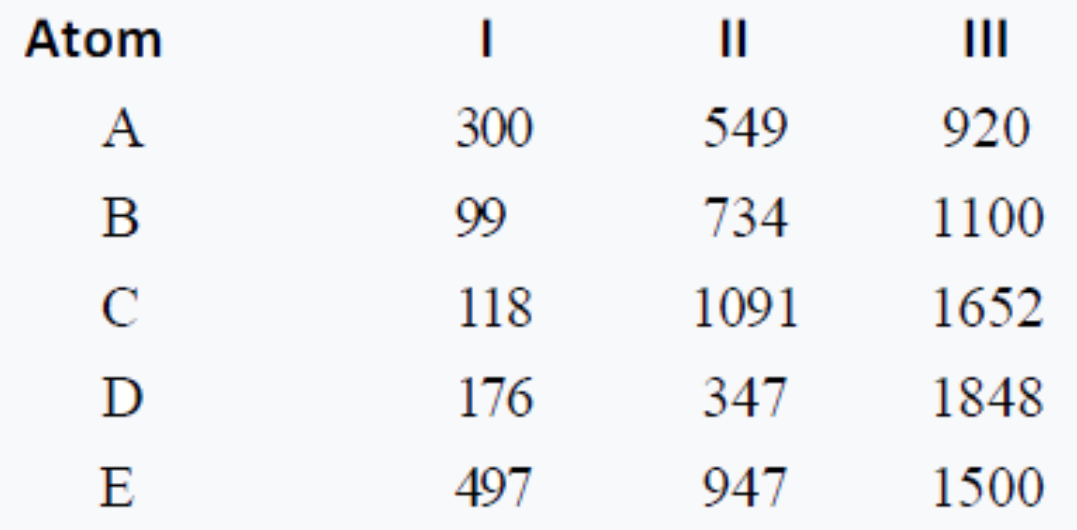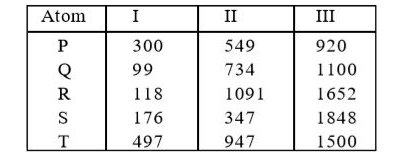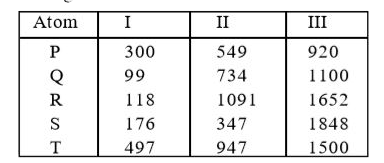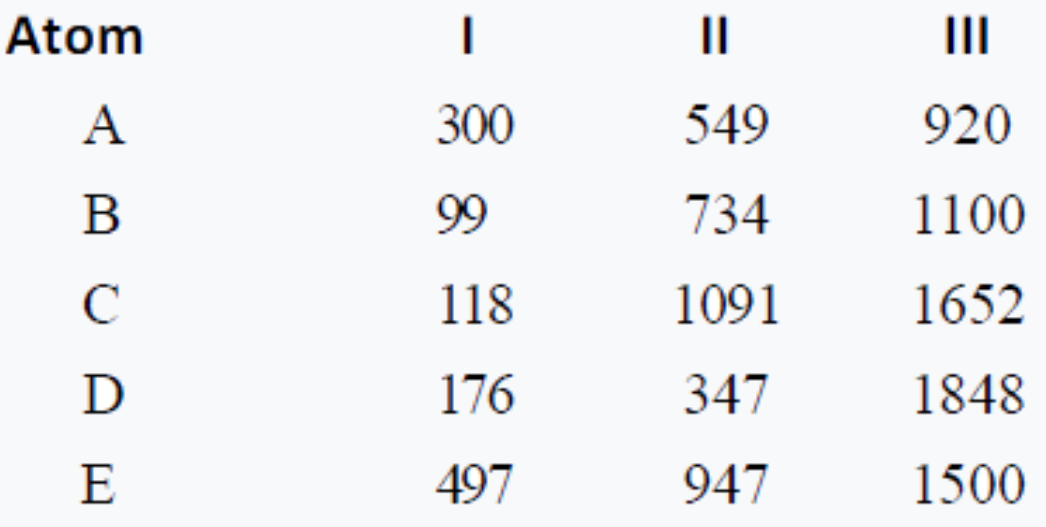There are three elements I, II, III and their ionisation energies are given below.
IE1IE2I23725251II9001760III5207300
Now identify
(a) Which element is most reactive ?
(b) Which element is noble gas ?
(c ) Which can form a stable dihalide ?
To solve the question, we need to analyze the given ionization energies of the three elements (I, II, III) and draw conclusions based on their values.
1. Identify the Ionization Energies:
- Element I: IE1 = 2372 kJ/mol, IE2 = 5251 kJ/mol
- Element II: IE1 = 900 kJ/mol, IE2 = 1760 kJ/mol
- Element III: IE1 = 520 kJ/mol, IE2 = 7300 kJ/mol
2. Determine the Most Reactive Element:
- The reactivity of an element is generally inversely related to its ionization energy. The lower the ionization energy, the easier it is to remove an electron, making the element more reactive.
- Among the three elements, Element III has the lowest first ionization energy (520 kJ/mol).
- Conclusion: Element III is the most reactive.
3. Identify the Noble Gas:
- Noble gases have very high ionization energies because they have a complete octet and do not readily lose or gain electrons.
- Element I has the highest first ionization energy (2372 kJ/mol) among the three elements.
- Conclusion: Element I behaves like a noble gas.
4. Determine Which Element Can Form a Stable Dihalide:
- A stable dihalide (e.g., MCl2) requires the element to lose two electrons, which corresponds to having a low second ionization energy.
- The second ionization energy of Element II is 1760 kJ/mol, which is lower than that of Element I (5251 kJ/mol) and Element III (7300 kJ/mol).
- Conclusion: Element II can form a stable dihalide.
Final Answers:
(a) Element III is the most reactive.
(b) Element I is the noble gas.
(c) Element II can form a stable dihalide.
- Element I: IE1 = 2372 kJ/mol, IE2 = 5251 kJ/mol
- Element II: IE1 = 900 kJ/mol, IE2 = 1760 kJ/mol
- Element III: IE1 = 520 kJ/mol, IE2 = 7300 kJ/mol
- The reactivity of an element is generally inversely related to its ionization energy. The lower the ionization energy, the easier it is to remove an electron, making the element more reactive.
- Among the three elements, Element III has the lowest first ionization energy (520 kJ/mol).
- Conclusion: Element III is the most reactive.
- Noble gases have very high ionization energies because they have a complete octet and do not readily lose or gain electrons.
- Element I has the highest first ionization energy (2372 kJ/mol) among the three elements.
- Conclusion: Element I behaves like a noble gas.
- A stable dihalide (e.g., MCl2) requires the element to lose two electrons, which corresponds to having a low second ionization energy.
- The second ionization energy of Element II is 1760 kJ/mol, which is lower than that of Element I (5251 kJ/mol) and Element III (7300 kJ/mol).
- Conclusion: Element II can form a stable dihalide.
(a) Element III is the most reactive.
(b) Element I is the noble gas.
(c) Element II can form a stable dihalide.
Topper's Solved these Questions
- CLASSIFICATION OF ELEMENTS AND PERIODICITY IN PROPERTIESBOOK - AAKASH INSTITUTE ENGLISHCHAPTER - CLASSIFICATION OF ELEMENTS AND PERIODICITY IN PROPERTIESEXERCISE - Assignment (Section - J Aakash Challengers Questions)
6 Videos
- CLASSIFICATION OF ELEMENTS AND PERIODICITY IN PROPERTIESBOOK - AAKASH INSTITUTE ENGLISHCHAPTER - CLASSIFICATION OF ELEMENTS AND PERIODICITY IN PROPERTIESEXERCISE - Assignment (Section - H Multiple True-False Type Questions)
3 Videos
- CHEMISTRY IN EVERYDAY LIFE BOOK - AAKASH INSTITUTE ENGLISHCHAPTER - CHEMISTRY IN EVERYDAY LIFE EXERCISE - Assignment ( SECTION - A)
45 Videos
- COORDINATION COMPOUNDS BOOK - AAKASH INSTITUTE ENGLISHCHAPTER - COORDINATION COMPOUNDS EXERCISE - Assignment (Section-J Aakash Challenger Questions )
10 Videos
Similar Questions
Knowledge Check
The first (IE1) and second (IE2) ionisation energies (kJmol−1) of a new elements designated by roman numerals are shown below:
IE1IE2I23705250II5207300III9001800IV17003400
Which of the above elements is likely to be :
a. A reactive metal
b. A reactive non-metal
c. a noble gas
d. A metal that forms a stable binary halide of the formula AX2 (X= the halogen).AI,2372,5251BII,520,7300CIII,900,1760DIV,1680,3380
Ionization energies of five elements in kcal/mol are given below:

Q. Which element is a noble gas?
View SolutionIonization energies of five elements in kcal/mol are given below:

Q. Which element is a noble gas?
View SolutionIonization energies of five elements in kcal/mol are given below:

Q. Which element form stable unipositve ion?
View SolutionIonization energies of five elements in kcal/mol are given below:

Q. Which element form stable unipositve ion?
View SolutionIonization energies of five elements in kcal/mol are given below:
 .
.
Which element forms stable unipositive ion ?
View SolutionThe IE1 and IE2(kJmol−1) of three elements A, B and C are given below :
ABCIE14005501150IE2265010702090
Identify the elements which represent (a) an alkali metal, (b) an alkaline earth metal or (c ) non-metal.
View SolutionIonization energies of five elements in kcal/mol are given below :

Which is non-metal (excluding noble gas) ?
View Solution


 .
.